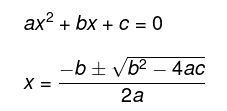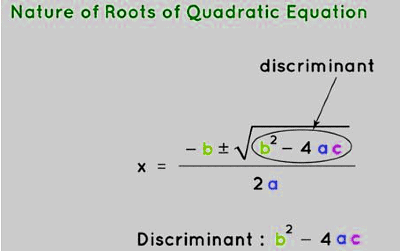Important Formulas: Quadratic Equations | Quantitative for GMAT PDF Download
| Table of contents |

|
| Quadratic Equation |

|
| Quadratic Equation Formula |

|
| Nature Of Roots Of The Quadratic Equation Formula |

|
| Sum And Product Of Roots Of Quadratic Equation Formula |

|
Quadratic Equation
A quadratic equation is a second-degree algebraic expression in the variable x, written in the standard format ax2+bx+c=0, where a and b are coefficients, x represents the variable, and c is the constant term. The coefficient of x2 must not be zero for the equation to be quadratic. In practical situations, quadratic equations can take different forms, but they need to be converted into the standard form before further operations.

Roots of a Quadratic Equation
The solutions of a quadratic equation correspond to the two values of ‘x’ achieved through solving the equation. These solutions, also referred to as the zeros of the equation, signify the points where the equation intersects the x-axis. For instance, considering the equation x2 – 3x – 4 = 0, the solutions are x = -1 and x = 4, as they both satisfy the equation:
When x = -1: (-1)2 – 3(-1) – 4 = 1 + 3 – 4 = 0
When x = 4: (4)2 – 3(4) – 4 = 16 – 12 – 4 = 0
Numerous approaches exist to ascertain the solutions of a quadratic equation, with one of these methods involving the use of the quadratic formula.
Quadratic Equation Formula
The quadratic formula serves as the most straightforward approach to determining the solutions of a quadratic equation. In instances where quadratic equations are challenging to factorize, the quadratic formula offers a convenient and efficient method to swiftly ascertain the solutions. Within the quadratic formula, both roots are presented in a unified expression. By employing either the positive or negative sign, the two distinct solutions of the equation can be derived interchangeably.
The quadratic formula can be expressed as follows: For a quadratic equation ax2+bx + c = 0, the roots are obtained using x = [-b ± √(b2– 4ac)] / 2a
This formula is also known as the Sridharacharya formula.
Nature Of Roots Of The Quadratic Equation Formula
The symbols alpha (α) and beta (β) commonly denote the roots of a quadratic equation. In this context, we will delve into methods for determining the characteristics of these roots without explicitly calculating their values.
The nature of the roots of a quadratic equation can be inferred without directly computing the roots themselves (α, β). This can be accomplished by evaluating the discriminant, an integral component of the quadratic equation solution formula. The quantity b2 – 4ac, known as the discriminant of the quadratic equation, is assigned the label ‘D’. By analyzing the value of the discriminant, predictions regarding the attributes of the roots of the quadratic equation can be made.
Discriminant: D = b2 – 4ac
- D > 0, the roots are real and distinct
- D = 0, the roots are real and equal.
- D < 0, the roots do not exist or the roots are imaginary.

Sum And Product Of Roots Of Quadratic Equation Formula
The coefficients of the quadratic equation, namely the term with x2, the term with x, and the constant term in ax2+bx+ c = 0, play a crucial role in determining both the sum and the product of the roots of the quadratic equation. It’s possible to directly compute the sum and product of these roots using the equation itself, without needing to explicitly calculate the individual roots.
For a quadratic equation ax2+bx+ c = 0, the sum and product of its roots can be derived as follows:
Sum of the Roots: α + β = -b/a = Negative Coefficient of x / Coefficient of x2
Product of the Roots: αβ = c/a = Constant term / Coefficient of x2
Writing Quadratic Equations Using Roots
A quadratic equation can also be constructed based on the provided roots of the equation. If α and β represent the roots of the quadratic equation, then the corresponding quadratic equation takes the following form:
x2 – (α + β)x + αβ = 0
Formulas Related to Quadratic Equations
Here is a summary of the important formulas that are useful for solving quadratic equations:
- The standard form of a quadratic equation: ax2+bx + c = 0,
- The discriminant of the quadratic equation: D = b2 – 4ac.
- For D > 0, the roots are real and distinct.
- For D = 0, the roots are real and equal.
- For D < 0, the roots are imaginary or do not exist.
- Formula for finding the roots of the quadratic equation: x = [-b ± √(b2 – 4ac)] / 2a.
- Sum of the roots of a quadratic equation: α + β = -b/a.
- Product of the roots of a quadratic equation: αβ = c/a.
- Quadratic equation with given roots α and β: x2 – (α + β)x + αβ = 0.
- Condition for two quadratic equations to have the same roots: (a1b2 – a2b1)(b1c2 – b2c1) = (a2c1 – a1c2)2.
- Minimum value of a quadratic expression when a > 0: f(x) = ax2+bx+ c has a minimum at x = -b/2a.
- Maximum value of a quadratic expression when a < 0: f(x) = ax2+bx+ c has a maximum at x = -b/2a.
- The domain of any quadratic function encompasses all real numbers.
|
121 videos|148 docs|111 tests
|















